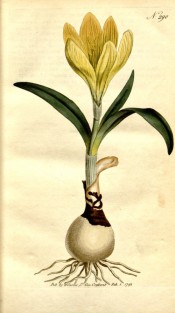Sternbergia lutea (L.) Ker-Gawl. ex Spreng.
A bulbous perennial, the narrowly lance-shaped leaves are produced at the same time as the goblet-shaped, deep yellow flowers in autumn. Very free-flowering. To 15cm. [RHSE, Hortus, Baker Am.].
Horticultural & Botanical History
First botanically described by Linnaeus as Amaryllis lutea in 1753 [Sp. Pl. p.292/1753] and placed in Sternbergia by Ker Gawler in 1827 [Syst. Veg. vol.22, p.57/1825].
According to Johnson's Dictionary Oporanthus lutea was introduced to Britain in 1596. Paxton's and Johnson's Dictionary describe a variety, luteus angustifolia, with narrow leaves, which may be S. sicula.
‘The Amaryllis lutea is a hardy perennial bulbous plant, a native of Spain, and other of the more Southern parts of Europe, and was cultivated in our Gardens in the time of Gerard, and Parkinson. Flora, who commences her revolutionary reign, by enlivening the flower border with the Spring Crocus, and its numerous varieties, terminates it with flowers equally pleasing, and of similar hues; thus we have the present plant, the Saffron Crocus, and the Colchicum, flowering nearly at the same time, from the end of September, through October, and sometimes part of November.
Similar as the Amaryllis is to the yellow Spring Crocus, in the colour, and form of its flowers, it differs obviously in the number of its stamina, the breadth of its leaves, and the size and colour of its root. Authors describe it as varying in size, in the breadth of its leaves, the height of its flowers, and multiplication of the Corolla.
The Dutch Florists export it under the title of yellow Colchicum, following the name of some of the old writers. It succeeds best in a soil moderately moist, in which it increases considerably by offsets, and flowers to the most advantage when the roots have remained for some few years undisturbed in the same spot.’ [BM t.290/1795].
History at Camden Park
Listed in all published catalogues [B.418/1843]. Sternbergia lutea is often mistaken for Sterbergia sicula Tineo in Australia and may not be in the country. The former has bright green leaves without a central stripe, the latter narrower, dark green leaves with a central, greyish stripe. This form has also been called S. lutea var. sicula in Australia. Baker considers S. sicula to be a form of S. lutea. [Baker Am.]. Sternbergia lutea is much more difficult to grow than S. sicula and, although listed consistently in the catalogues from 1843-1857, the latter may be the plant grown by Macarthur. Sternbergia lutea was ticked in a copy of the Horticultural Register, October 1831. Although the book originally belonged to James Bowman, it is likely that this plant was grown by the Macarthur family earlier than 1843.
Notes
Published May 28, 2009 - 05:16 PM | Last updated Aug 10, 2012 - 05:13 PM
| Family | Amaryllidaceae |
|---|---|
| Category | |
| Region of origin | Spain to Afghanistan |
| Synonyms |
|
| Common Name | Autumn daffodil, Winter daffodil, Yellow autumn crocus |
| Name in the Camden Park Record | Sternbergia lutea
|
| Confidence level | high |


